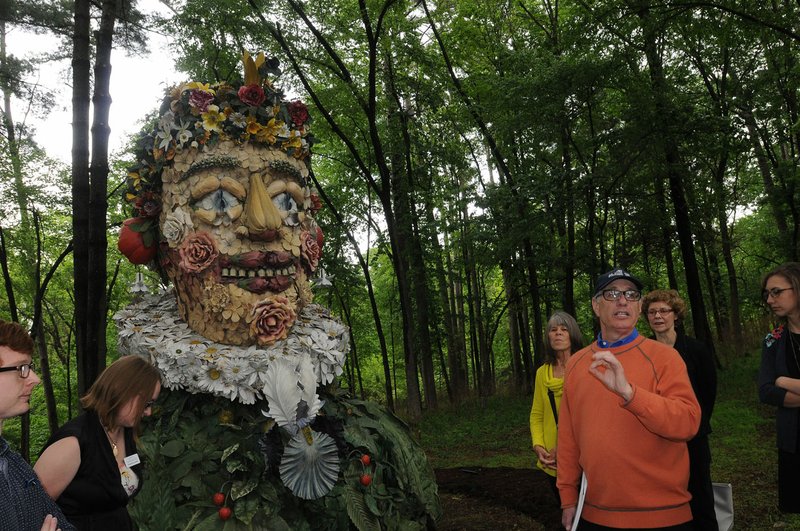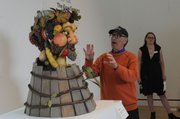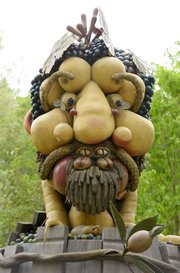Philip Haas' 15-foot sculptures, The Four Seasons, have been displayed in museums and botanical gardens across the United States, England and France.
Each time they arrive at a new location, the San Francisco-born artist considers it the "best place" for his work.
Haas felt the same as he scanned the tree line along the Orchard Trail at Crystal Bridges Museum of American Art in Bentonville last week as the finishing touches were put on the Spring and Summer pieces.
"It's just magical seeing these sculptures revealed in the trees," Haas said. "Particularly when you're walking up. The idea is that they've lived here forever, that they've grown from the ground."
Crystal Bridges announced the installation of The Four Seasons, on loan from the Sonnabend Gallery in New York, early last week and unveiled the sculptures Friday. Three of the fiberglass pieces -- Spring, Summer and Autumn -- are on display along the main path that leads to the museum's main entrance. Winter has been placed in the courtyard.
Curator Dylan Turk believes Haas' work will be popular among Crystal Bridges guests. It represents a first for the museum because of the sections' location along the trail tree line. Three-foot-tall maquettes -- smaller replicas of the four sculptures -- are located inside the museum.
The Four Seasons will be on display at the museum through September.
"We're really trying to get our guests that only go inside to go outside. And those guests that only use our trails to come inside," Turk said. "So we're kind of scattering this installation throughout the whole museum. ... As we are growing, we're wanting to have that indoor/outdoor experience more than we've had before. This, I think, is really going to help do this."
The sculptures are three-dimensional interpretations of Giuseppe Arcimboldo's four 1563 Italian Renaissance paintings: Spring, Summer, Autumn and Winter. Arcimboldo's paintings are profiles of human heads consisting of fruits, vegetables, plants and trees, something Haas has expounded on and brought to life.
His work started, Haas said, as an "idea for an idea" when he wanted to create a large-scale sculpture for a garden. Winter, which took five months to complete, was created for a 2010 exhibition at the National Gallery of Art in Washington, D.C. Haas and his team built the next three over a six-month period, completing his vision of Arcimboldo's works.
Each piece contains elements of its seasons. Haas said Winter, with its bark, ivy and headdress of twisted tree branches, is the most popular. Summer features a cucumber nose, fruits and seasonal foliage. Roses and daisies are among 100 flowers found in Spring, and Autumn features a cornucopia of pumpkins, grapes, and other fruits and vegetables.
"Philip has taken [Arcimboldo's] idea and brought it into contemporary times," Turk said.
Crystal Bridges became interested in the pieces after staff members saw them at their previous stop outside the Nelson-Atkins Museum of Art in Kansas City, Mo. There, the sculptures were centered in the courtyard around Auguste Rodin's The Thinker.
Steve Waterman, director of presentation at the Nelson-Atkins Museum, said the lack of grass around the pieces was an indication of how popular they were. Heavy foot traffic kept the sod from growing.
"They probably come at audiences in two different ways," Waterman said. "Your fine arts audience might understand the relationship between these works and the original paintings. Then your non-art community, they come at them just because they're wonderful, fun and easy to understand."
Crystal Bridges now joins the list of places that have displayed The Four Seasons. Others have included the New York Botanical Gardens, Phoenix's Desert Botanical Gardens and London's Dulwich Picture Gallery. The Bentonville museum is the first place where all four sculptures haven't been displayed together, but Haas said Crystal Bridges has provided an opportunity to present them in a unique way, in keeping with the museum's mission of merging art and nature.
"I like the idea of the sculptures being outside the museum so you're not sure if they're fleeing the museum or they're trying to get back inside," Haas said.
Haas works with a team of four to take down, ship and install the work. The sculptures are dismantled into four or five pieces, a process that takes three to four hours. Each piece travels in a 51-foot tractor trailer, and it takes four to five hours to install them again.
The fiberglass sculptures are relatively durable, and Haas believes they've aged well.
On Monday, Spring, Summer and Fall received paint touch-ups as they were installed along the Orchard Trail. Winter was installed in the courtyard the next day.
"I think they look better as they age because they reference old master paintings," Haas said.
Haas discussed the work and his career with museum guests during a question-and-answer session Friday, describing himself as a "recovering film director." He directed movies like The Music of Chance (1993), Angels and Insects (1995) and The Situation (2006), but left filmmaking after getting an appetite for "doing things outside of cinema."
His project Butchers, Dragons, Gods and Skeletons was named one of the top 10 shows of 2009 by Time Magazine. For the Kimbell Art Museum in Fort Worth, Haas made films interpreting five of the museum's paintings. He has since gravitated to sculptures, describing himself as a contemporary surrealist who wants to make a "visceral experience."
Haas said the reaction to The Four Seasons at every stop has been "terrific."
"The response has been so enthusiastic," he said. "Not only from a typical museum public, but also young kids love it. You don't have to have an art education. You immediately see that these are composite sculptures made of fruit, vegetables and flowers. You don't need a handbook. And I think people respond to narrative art. Art that is representational."
Metro on 05/01/2016


